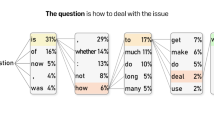Abstract
A new system of dynamic logic is introduced and motivated, witha novel approach to variable binding for incremental interpretation. Thesystem is shown to be equivalent to first order logic and complete.
The new logic combines the dynamic binding idea from DynamicPredicate Logic with De Bruijn style variable free indexing. Quantifiersbind the next available variable register; the indexing mechanismguarantees that active registers are never overwritten by newquantifiers actions. Apart from its interest in its own right, theresulting system has certain advantages over Dynamic Predicate Logic orDiscourse Representation Theory. It comes with a more well behaved(i.e., transitive) consequence relation, it gives a more explicitaccount of how anaphoric context grows as text gets processed, and ityields new insight into the dynamics of anaphoric linking in reasoning.Incremental dynamics also points to a new way of handling contextdynamically in Montague grammar.
Similar content being viewed by others
References
Aczel, P., 1996, “Variable binding,” Notes of a talk for Accolade, Plasmolen.
Barendregt, H., 1984, The Lambda Calculus: Its Syntax and Semantics, 2nd edn., Amsterdam: North-Holland.
Barwise, J., 1987, “Noun phrases, generalized quantifiers and anaphora,” pp. 1–30 in Generalized Quantifiers: Linguistic and Logical Approaches, P. Gärdenfors, ed., Dordrecht: Reidel.
Beaver, D., 1999, “The logic of anaphora resolution,” pp. 61–66 in Proceedings of the Twelfth Amsterdam Colloquium, December 18–21, P. Dekker, ed., Amsterdam: ILLC.
Ben-Shalom, D., 1994, “A path-based variable-free system for predicate logic,” Technical Report CS-89444, Amsterdam: CWI.
Blackburn, P. and Venema, Y., 1995, “Dynamic squares,” Journal of Philosophical Logic 24, 469–523.
Clark, R. and Kurtonina, N., “Consequences from Quine,” pp. 91–95 in Proceedings of the Twelfth Amsterdam Colloquium, P. Dekker, ed., Amsterdam: University of Amsterdam.
De Bruijn, N.G., 1980, “A survey of the project AUTOMATH,” pp. 579–606 in To H.B. Curry: Essays on Combinatory Logic, Lambda Calculus and Formalism, J.R. Hindley and J.P. Seldin, eds., London: Academic Press.
Dekker, P., 1994, “Predicate logic with anaphora,” p. 17vv in Proceedings of the Fourth Semantics and Linguistic Theory Conference, L. Santelmann and M. Harvey, eds., Cornell University, DMML Publications.
Groenendijk, J. and Stokhof, M., 1991, “Dynamic predicate logic,” Linguistics and Philosophy 14, 39–100.
Gunter, C.A, 1992, Semantics of Programming Languages, Cambridge, MA: MIT Press.
Heim, I., 1982, “The semantics of definite and indefinite noun phrases,” Ph.D. Thesis, University of Massachusetts, Amherst.
Hollenberg, M., 1997, “An equational axiomatisation of dynamic negation and relational composition,” Journal of Logic, Language and Information 6, 381–401.
Kamp, H., 1981, “A theory of truth and semantic representation,” pp. 277–322 in Formal Methods in the Study of Language, J. Groenendijk, T. Janssen, and M. Stokhof, eds., Amsterdam: Mathematisch Centrum.
Kamp, H. and Reyle, U., 1993, From Discourse to Logic, Dordrecht: Kluwer Academic Publishers.
Kamp, H. and Reyle, U., 1996, “A calculus for first order discourse representation structures,” Journal of Logic, Language and Information 5, 297–348.
Kuhn, S., 1983, “An axiomatisation of predicate functor logic,” Notre Dame Journal of Formal Logic 24, 233–241.
Purdy, W.C., 1991, “A logic for natural language,” Notre Dame Journal of Formal Logic 32, 409–425.
Quine, W.V.O., 1996, “Variables explained away,” pp. 227–235 in Selected Logic Papers, New York.
Sánchez, V., 1991, “Studies on natural logic and categorial grammar,” Ph.D. Thesis, University of Amsterdam.
Saurer, W., 1993, “A natural deduction system for discourse representation theory,” Journal of Philosophical Logic 22, 249–302.
van Benthem, J., 1987, “Meaning: Interpretation and inference,” Synthese 73, 451–470.
van Eijck, J., 1993, “The dynamics of description,” Journal of Semantics 10, 239–267.
van Eijck, J., 1999, “Axiomatising dynamic logics for anaphora,” Journal of Language and Computation 1, 103–126.
van Eijck, J. and Kamp, H., 1996, “Representing discourse in context,” pp. 179–237 in Handbook of Logic and Language, J. van Benthem and A. ter Meulen, eds., Amsterdam: Elsevier.
Vermeulen, C.F.M., 1993, “Sequence semantics for dynamic predicate logic,” Journal of Logic, Language, and Information 2, 217–254.
Visser, A., 1994, “The design of dynamic discourse denotations,” Lecture Notes, Utrecht University.
Visser, A., 1997, “Dynamic relation logic is the logic of DPL-relations,” Journal of Logic, Language and Information 6, 441–452.
Visser, A. and Vermeulen, C., 1996, “Dynamic bracketing and discourse representation,” Notre Dame Journal of Formal Logic 37, 321–365.
Author information
Authors and Affiliations
Rights and permissions
About this article
Cite this article
van Eijck, J. Incremental Dynamics. Journal of Logic, Language and Information 10, 319–351 (2001). https://doi.org/10.1023/A:1011251627260
Issue Date:
DOI: https://doi.org/10.1023/A:1011251627260




